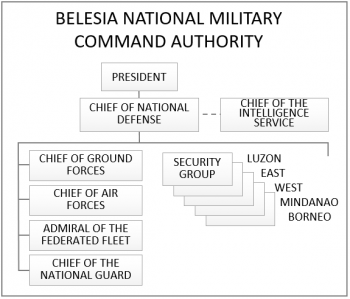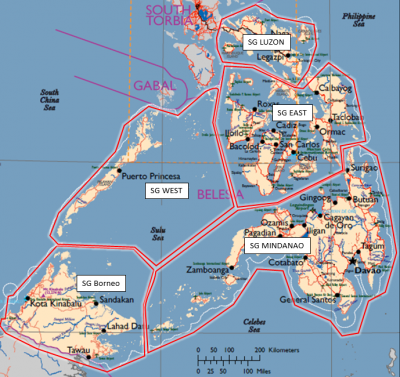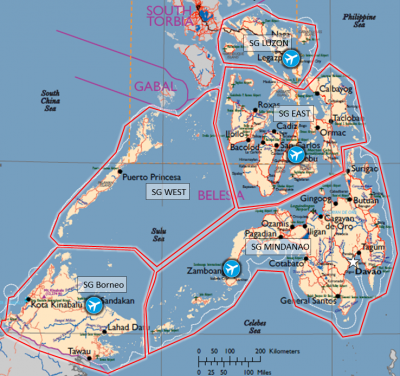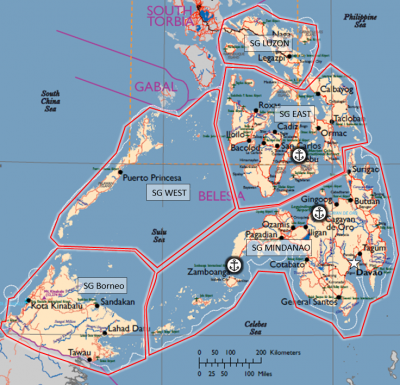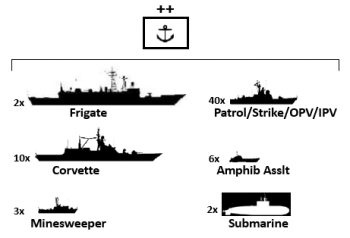Military: Belesia
The Belesia Federation Defense Force (BFDF) includes the Belesian Army, Air Force, and Navy. The military components have a relatively high degree of cooperation and interdependence. This is largely due to numerous complex and rapidly developing security missions. These roles are generally divided into national defense, internal security, counter-insurgency, and stability support operations.
The BFDF has come a long way since the creation of the Federation in 1946. The most significant development is the formalization and aggregation of member islands’ inconsistent security efforts. This standardization and professionalism is most evident in the establishment of a national constabulary and a national guard. Maintaining a balance between enforcing nationhood and preserving a degree of local autonomy has been the major challenge to national policy implementation and military stationing efforts.
Military Forces
The military forces and inventories of the BFDF are developing alongside its national economy, with special emphasis on high-payoff investments, such as air defense and technological improvements to existing systems. The state armed forces rely heavily on its paramilitary and civil defense elements. The Belesia Federation National Guard (BFNG) maintains a presence throughout the archipelago and is charged with supporting local security and local interests. The Belesia Constabulary maintains local security - particularly on the smaller islands, where they may be the only security capability present. Despite cooperation and numerous joint operations, tensions persist between the BFNG and the local Constabulary elements as state authorities increasingly press national priorities and policies.
Religious, ethnic, tribal, and clan tensions are endemic to relations among the various forces, but are secondary to the tension between Federation and local issues. The BFDF has emphasized ethnic and gender inclusiveness wherever possible, but many of the local forces strongly reflect their local populations and cultural norms.
Defense spending as a percentage of GDP has increased over the last few years to an average of 1.51% of GDP.
National Command Authority
The National Command Authority of Belesia exercises overall control to plan and carry out the national security strategy. The Belesian Chief of National Defense is the senior military position in the chain of command, subordinate to the Belesian President. Service Chiefs (Ground, Air, Naval, National Guard) are responsible for their respective forces. The services will contribute personnel and resources to the Security Groups under operational control (OPCON) as requirements dictate.National Strategic Goals
The Federated States of Belesia are in near-constant tension as member islands both require and resist national assistance to varying degrees. Longstanding ethnic and cultural tensions combine with pressures from internal non-state actors, external threats, and pervasive criminal activity. As the country’s economic status has developed, the administration has adopted a number of policies intended to provide a national-level security capability while preserving local governance. The Security Forces Reorganization Act, enacted during the previous administration, has been generally regarded as the most beneficial policy in decades for enhancing the national nature of the Federation. Military priorities outlined in the Security Forces Reorganization Act include:
- Defense of the Federation against foreign state and non-state threats
- Counter-insurgency
- Counter-piracy and counter-smuggling
- Support to humanitarian crises and disaster relief (HADR)
- Protection of environmental resources
Military Forces Overview
Due to the dispersed nature of Belesia’s member islands and range of potential security issues, Belesia divides security responsibilities into five Security Groups. Security Group commanders often coordinate on a variety of operations, but retain a high degree of autonomy within their area of responsibility. Security Group commanders are nominated by the Chief of National Defense and are approved by the President| Security Groups | Issues |
| SG Luzon | Border security, smuggling |
| SG West | Smuggling, HADR |
| SG East | COIN, smuggling |
| SG Mindanao | Maritime security, COIN |
| SG Borneo | Border security, smuggling, COIN, HADR |
Army Overview
The Belesia Federation Army (BFA) is a robust, but developing ground force comprised of a conventional military capable of conducting a wide range of operations and a layered paramilitary capability. Ground forces, excluding the paramilitary groups, are an estimated 98,500 troops, of which 55,400 are active and 43,100 are ready reserve. Its forces currently consist of three infantry divisions, an armored division, an aviation regiment, a Special Purpose Forces regiment, an engineer brigade, and a transportation regiment. The paramilitary elements (see below) have both active and reserve manning, which can be mobilized to augment the army.
The primary roles of the Belesian Army align with the national military goals of ensuring the sovereignty and territorial integrity of the country by guarding against external aggression, both conventional and unconventional; to suppress violent insurgencies and other extremists; to combat criminal operations; and to provide assistance to humanitarian crises and disaster relief.
Army Size and Structure
Maneuver brigades serve as Belesia’s basic combined arms unit. The major maneuver units of the BFDF are administratively aligned along divisional affiliations, but similar to the other services, are task organized and placed under OPCON among the Security Groups. Non mission-specific or specialized capabilities, such as aviation and engineer, are often based near the capitol.The BFDF structures its maneuver brigades to provide maximum flexibility. Maneuver battalions and companies are tasked organized to conduct operations independently or as part of a task-organized element.
Doctrine and Tactics Belesian ground force doctrine is largely in support of the Security Groups’ requirements. The emphasis is to provide a viable defense of the nation, while preserving the ability to deploy rapidly in support of internal security requirements. Belesia sees its layered security posture as essential to maintaining Federation integrity and stability. This ability to respond at a local level, while retaining the capability to escalate forces as needed has generally proven successful in quelling internal security issues and responding to low-level insurgent-based incidents. Larger counter-insurgency (COIN) operations require additional coordination and force generation to a given locality to enable a viable response.
While the combined arms doctrine largely reflects the influence of U.S. training and operations, much of the Belesian counter-insurgency and small unit doctrine is a composite of highly effective local jungle fighting experiences. When conducting COIN operations on a member island, Belesian forces prefer to stage in a relatively secure support zone, develop intelligence situational awareness, and launch a series of violent attacks against what is identified as the threat center of gravity.
Reflecting its Western advisors, Belesian ground forces employ tactical control measures, including assembly areas, forming-up assembly areas just prior to attacks, advance axes, checkpoints, jump-off lines, and attack lines.
Training and Readiness
Belesia fields a competent, well-trained and overall professional military force in support of its stated national priorities. Its training and cooperation agreements with the U.S. and other partners has enabled faster growth and development than comparable forces in the region. The Belesian forces continue to experience the personnel and training limitation of any relatively young force. Maneuver divisions maintain responsibility for unit training requirements even when those forces are operating in support of a Security Group. Training for above company0sized elements are centralized at a [CENTER NAME] training facility near [TOWN]. Company and below training is managed by unit commanders. Most units maintain a 65% operational readiness rate.
Most military training is conducted at the Federation Military Academy near Cotabato City, Mindanao. It is a multi-service training facility that hosts all services, including the National Guard and initial training for Constabulary personnel. Most infantry personnel are graduates of either U.S. or Belesian Jungle School and highly capable of conducting operations under difficult conditions.
The singular detractor in Belesia’s military readiness is a pronounced realignment of resources toward internal security that may have long-term negative consequences for the Belesian Armed Forces’ ability to challenge external intrusions. This shift worsens the long-standing imbalance in terms of purchases that benefit army modernization versus maritime and aerial surveillance.
Weapons and Equipment
The Belesia Federation Defense Force equipment and weapons largely reflect an odd mix of Tier 3 systems, but some units may be almost exclusively Tier 2 or 4. Policy shift towards technical capabilities, rather than additional tactical unit materiel threaten to allow stocks to age. Belesian used to be mostly Donovian in origin, but more than a decade of foreign advisors and international assistance has diversified an inventory that now includes a number of Olvanan variants and even selected western systems. The inclusion of Olvanan weaponry may be a result of developing economic ties to the regional giant.
Functional Capabilities
Command and Control
The Belesian military maintains a constitutionally-mandated civilian control and structure based on the Security Forces Reorganization Act. It has developed a positive degree of trust across all echelons. Professional military training filled its ranks with competent leaders who can operate independently. In recent years, Belesia has recognized potential threats to its command and control (C2) capabilities and has invested to mitigate such threats through technological defenses and decentralizing wherever viable.
C2 at the tactical level emphasizes survivability through mobility, communications redundancy, and rigorous operations security. Command posts and procedures are streamlined at the operational level, relying heavily on common procedures for important recurring tactical tasks.
(See also TC 7-100.2: Opposing Force Tactics, Chapter 2, Command and Control)
Maneuver
The Belesian military has a developing, yet robust capability to conduct combined arms operations. Maneuver brigades serve as Belesia’s basic combined arms unit. The major maneuver units of the BFDF are administratively aligned along divisional affiliations, but similar to the other services, are task organized and placed under operational control (OPCON) among the Security Groups. Non mission-specific or specialized capabilities, such as aviation and engineer, are often based near the capitol.
Tactically, maneuver elements will seek to contain a threat situation, with indirect fires or rapid strikes as the decisive actions. They have demonstrated high degrees of competence when conducting operations in mountainous and jungle terrain and can operate with relative ease, even without night vision devices.
Air Defense
Belesian leadership believes that the primary threat from neighbor states is by air and has invested heavily to counter potential threats. All maneuver units have significant organic air defense assets, with each division having a dedicated air defense regiment in addition to the capabilities of its subordinate units.
All ground units possess organic air defense capabilities to differing degrees, depending on the type and size of the unit. Maneuver and paramilitary forces are also trained to use organic direct fire systems, such as heavy machine guns and even some anti-tank guided missiles, in an air defense capacity. Belesia also has a dedicated air defense regiment that is responsible for larger systems and point defense.
Belesia continues to seek technological enhancements to further develop an integrated air defense system (IADS). This capability would provide a continuous and overlapping umbrella of coverage around the dispersed member islands and present a significant defense against most potential enemy air activity.
(See also TC 7-100.2: Opposing Force Tactics, Chapter 11, Air Defense)
INFOWAR
Belesia continues to develop its INFOWAR capability. Currently, Belesia’s strategic INFOWAR consists of a cultivated network of connections with media outlets throughout the archipelago which facilitates rapid dissemination of messaging.
Belesia’s dispersed citizenry relies heavily on mobile devices. This, combined with a very limited number of service provides could make mobile-based perception management highly effective if network security can be maintained. Service hubs and telecommunications nodes have been a favorite target for a number of insurgent and separatist groups over the years. Reliance on global position systems is a significant risk for both government and private navigation users. GPS jamming and spoofing have been highlighted by the President as a serious concern for all Belesians due to the number of key systems dependent on GPS. For military systems is could significantly impact targeting and UAV capabilities. The age of many of the most common system throughout Belesia leaves them vulnerable to even basic interference.
Belesia does not an offensive cyber operations capability, but emphasizes defensive measure throughout its military training programs. Belesian is cooperating with multiple commercial entities to enhance its strategic defensive cyber posture.
(See also TC 7-100.2: Opposing Force Tactics, Chapter 7, Information Warfare )
RISTA
Reconnaissance, intelligence, surveillance, and target acquisition (RISTA) across the breadth of Belesia’s member islands is a constant challenge, ye ton e of the most important for maintaining its internal stability and national defense. Belesia’s most effective RISTA capability is its longstanding and well-integrated human intelligence network. This network is particularly strong in and around build-up areas and cities, but is still developing in the outlying islands.
Although most of Belesia’s military RISTA capabilities reside in the air force, most maneuver units have UAVs and reconnaissance units that provide tactical situational understanding. With many of its citizens reliant on mobile devices for information, it is assumed that Belesian intelligence is capable of leveraging metadata derived from mobile devices and internet access points. Belesia does not have an organic space-based capability and is dependent on commercially-available imagery or imagery shared by its strategic partners.
Fire Support
Belesian military doctrine leverages indirect fires (IDF) as a decisive strike capability in support of tactical operations. A maneuver division generally has 2-3 brigade-sized IDF units in addition to organic IDF assets at maneuver brigades and below. Most IDF systems are self-propelled and usually wheeled. Belesian forces may also integrate air assets as available into integrated attacks against threat key systems. Belesian IDF capabilities have been honed during numerous peacekeeping deployments. Technical enhancements will likely increase the accuracy and integration of the entire spectrum of fire support systems.
(See also TC 7-100.2: Opposing Force Tactics, Chapter 9, Indirect Fire Support)
Protection
Belesian military engineer elements are highly capable, but they have not often been used in direct support of military operations. They primary military support is to maintain ground mobility – particularly for heavy forces. A particular emphasis is strategic site protection against potential Missile or air attacks from North Torbia.
They are most often used in support of humanitarian crises and disaster relief operations. In addition to hardening the defensive posture of key government and military sites, they excel at maintaining land infrastructure, such as roads and airfields. Belesian engineers units may supplement manpower for these types of operations with local labor. This also serves to deepen ties and build relationships between the Federated government and local leaders.
(See also TC 7-100.2: Opposing Force Tactics, Chapter 12, Engineer Support)
Logistics
The Belesian military maintains a robust and networked logistics capability that can support its maneuver units for extended periods. This not only enables prolonged uninterrupted military operations, but supports remote operations despite weather-related supply delays. Belesian leaders continue to improve its logistics systems to enhance push-type supply flow to ensure local stockpiles remain at full strength and lines of communication are utilized to maximum effectiveness. Tactical level logistic, equipment, health services, infrastructure and administrative support are normally conducted by the individual components, but require coordination across the wider joint operations area.
The often poor of non-existent ground lines of communication throughout Belesia’s islands has moved much of the inter-island, and even same-island, movement to the numerous small watercraft. The military contracts to local providers to supplement its relatively small fleet of such watercraft. The Security Forces Reorganization Act gives military traffic on the “Federated Nautical Highway” and the authority to commandeer watercraft in cases of national emergency. Military leaders prioritize and stage materiel shipments to minimize impact on private shipping providers and prevent local backlash.
CBRNE
Belesia does not have an offensive CBRNE capability, nor is it part of their warfighting doctrine. All units receive defensive training and have a basic chemical defense capability. Emergency responders in all cities have more advanced capabilities for mass casualty care.
Belesia Federation Air Force (BFAF)
The Belesia Federation Air Force (BFAF) is capable of supporting ground combat and limited defensive air operations. Its primary roles are transportation, ground attack, and limited air-to-air. The air forces have been used to support peacekeeping deployments in all of these roles. It is well-integrated into ground force operations within the various Security Groups and it well suited for defensive operations and support to limited force projection.Air Force Size and Structure
The BFAF fields an estimated 35-40 fixed wing combat aircraft and 40-45 fixed-wing transports. Its forces operate primarily from bases in Legazpi (Luzon), Cebu City (Mactan), Zamboanga (Mindanao), and Sandakan (Borneo). Belesia doesn’t not have dedicated air bases, but maintains facilities at these and many smaller civilian airfields throughout the archipelago. Under the Security Forces Reorganization Act, the President may authorize military use of civilian airfields during times of national emergency or civil disturbance.
Air Force Doctrine and Tactics
The Belesian air force disperses most of its aircraft and support assets at its four main bases to enable support across the breadth of the archipelago. Air assets, like other military forces, will generally be under operational control (OPCON) to a Security Group. Belesia’s fixed-wing assets will generally provide decisive strike capability in support of tactical ground operations. Air forces, unless otherwise tasked, will provide support across Security Groups for training and logistical support. If crisis situations arise in a given Security Group, the air force may push additional platforms or position assets to a more forward airfield.
Air Force Weapons and Equipment
The Belesia air force operates a variety of equipment and weapons which are generally Tier-2 or 3 capability. Surveillance aircraft may have been fitted with niche Tier 1 equipment that provide advanced capabilities, such as surveillance and targeting. The Belesia air force can conduct 24-hour operations in all weather and over all terrain. The Belesia aircraft inventory includes equipment from U.S., Donovia, and Olvana. All rotary-wing assets are under the Belesia Federation Army for tactical support and transport.
Air Combat Group:
- Fighter/Intercept SQDN
- 2x Ground Attack SQDN
- Intelligence and Surveillance SQDN
Air Transport Group
- 2x Medium Air Transport SQDNs
- Light Transport/Training SQDNs
Air Force Training and Readiness
The Belesian air force maintains a moderate level of training and an estimated 65% operational readiness rate. This is largely due to its relatively small budget and high cost of maintaining its aging and diverse platforms. Belesian pilots have trained with both U.S. and Olvanan forces and many have experience gained from deployments in support of peacekeeping operations. Most pilots are trained to provide close air support, aided by linked ground location tracking systems.
Paramilitary Forces
Belesia Federation National Guard (BFNG). The BFNG is the primary national security and paramilitary unit of the Belesian armed forces. Its missions include implementation of national-level military and security policies, support to humanitarian assistance and disaster relief operations, and support to local constabulary elements. They are directly subordinate to the Chief of National Defense, but are commonly placed under operational control (OPCON) of a Security Group (SG) commander.
The BFNG may be mobilized to support specific military operations under Presidential authorization. This change, among others, is a result of the Security Forces Reorganization Act and had the effect of reducing the BFNG’s autonomy. Reports and rumors of excessive force have increased tensions between the BFNG and the local populace and Constabulary. Most BFNG personnel are former military or have trained with the military. An abbreviated initial training is required, as well as periodic professional develop courses and participation in training exercises.
BFNG units will be battalion or company-sized motorized forces – similar to the army, but lacking the artillery. Vehicles and heavy weapons will be stored in local armories, along with a basic supply of food and ammunition. Some units have experienced alleged theft of these stores, but most cases are often discovered to be internal theft and corruption.
Belesia Constabulary. The Belesian Constabulary is an adaptation of local security forces and functional more as a local paramilitary force than a policing element. In addition to local patrolling and static security, they may also support local police and security elements. Constabulary elements may be mobilized to support specific Federation operations, but only under Presidential order and parliament approval in accordance with the Security Forces Reorganization Act. Most Constabulary elements retain their heavy weapons and the small arms of their reserve personnel in centralized local armories. Many personnel working in their local Constabulary are former military or have trained with the military on specific support tasks.
The composition of Constabulary elements may vary significantly, but generally follow these models:
| Category 1 | Company-sized militia-type force, consisting of a mix of full-time and reserve personnel. May have heavy machine guns, anti-tank weapons, mortars, and standard military or technical vehicles. |
| Category 2 | Platoon-sized militia-type force, consisting of a mix of full-time and reserve personnel. May have heavy machine guns, anti-tank weapons, and standard military or technical vehicles. |
| Category 3 | Less than platoon-sized security force, consisting of trained reserve response personnel. May have light machine guns, possible anti-tank weapons, and civilian vehicles. |
| Category 4 | Multiple, small teams of trained volunteer personnel. These teams and individuals will usually work in-concert with one of the other type of Constabulary groups or National Guard to provide presence and local patrolling. |
(See also TC 7-100.2: Opposing Force Tactics, Chapter 15, Special Purpose Forces and Commandos.)
Belesia Federation Fleet (BFF)
The Belesia Federation Fleet (BFF) has military responsibility for maritime security within the entirety of Belesian territorial waters. It is a relatively small force, but Belesian has announced plans to expand the fleet and enhance the capabilities of its existing inventory. Belesian maritime operations have evolved to be very similar to its regional neighbors, focusing on coastal defense with moderate force projection capabilities. Their doctrine centers on defense with a heavy emphasis on enabling force projection. It also has primary responsibility for countering smuggling and piracy throughout the archipelago. Belesian naval missions include:
- Patrolling and defense of coastal areas
- Combating maritime crime, smuggling, and piracy
- Maritime and aerial surveillance
- Supporting humanitarian assistance and disaster relief
- Search and rescue
- Combating threats to the environment
The Belesian Federation Fleet headquarters is collocated with the civilian port at Cagayan de Oro. It also maintains ports for its larger vessels at the ports of Cebu City and Zamboanga. Under the Security Forces Reorganization Act, the President may authorize military use of civilian port facilities and even civilian vessels during times of national emergency or civil disturbance.
The BFF fields largely Tier 2 vessels and weapons with limited Tier 1 niche capabilities mostly evident in navigation upgrades and reconnaissance platforms.
Belesian naval equipment focuses on defensive operations and supporting ground force projection. Belesia will continue to purchase equipment such as minesweepers and landing craft, and improve amphibious assault capabilities. The BFF can operate in all sea conditions and can successfully conduct 24-hour operations.
The BFF possesses approximately 60 surface craft and reportedly 2 submarines. It operates a variety of surface combatants, patrol boats, minesweepers, and amphibious elements. The BFF also has a dedicated battalion of special purpose forces (SPF).
Belesian Naval Inventory:
- 2x Frigates
- 10x Corvettes
- 40x Patrol/Strike/OPV/IPV
- 3x Minesweepers
- 6x Amphibious assault
- 2x Submarines
The Belesian Federated Fleet is a composite of member island vessels and it continues to experience maintenance and training difficulties, despite efforts to professionalize and standardize its capabilities. Political statements on forcefully countering maritime crimes has resulted in only marginal budget increases, but new allocations have been put to good use by senior naval leaders. The overall readiness of the Belesian fleet is estimated at approximately 80%. Despite its budgetary and interoperability woes, it has a well-trained and motivated force, due mostly to a consistent training and professional development program, supported by international trainers.
| DATE Pacific Quick Links . | |
|---|---|
| Belesia | Political • Military • Economic • Social • Information • Infrastructure • Physical Environment • Time |
| Gabal | Political • Military • Economic • Social • Information • Infrastructure • Physical Environment • Time |
| North Torbia | Political • Military • Economic • Social • Information • Infrastructure • Physical Environment • Time |
| Olvana | Political • Military • Economic • Social • Information • Infrastructure • Physical Environment • Time |
| South Torbia | Political • Military • Economic • Social • Information • Infrastructure • Physical Environment • Time |
| Other | Non-State Threat Actors and Conditions |

